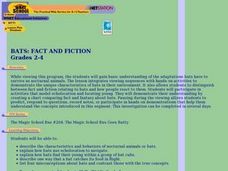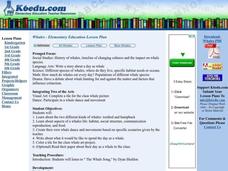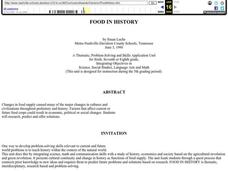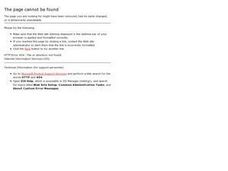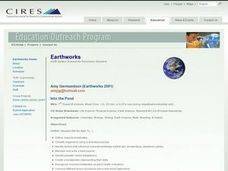Curated OER
Would You Like to Become a Millionaire?
Students answer questions written by other teams about literature in an attempt to become "millionaires." In small groups they write a motivational introduction to their teams selected books, publish their questions as a HyperCard...
Curated OER
Bats: Fact and Fiction
Students describe the characteristics and behaviors of bats. After viewing a video, they explain how bats use echolocation to navigate and how they find their young within a group. They list four misconceptions about the animal and...
Curated OER
Snowflake Crystals
Fourth graders explore physical changes and the true life story of Wilson Bentley. They observe the changes that take place with snowflakes. Students discuss what happens when snow flakes melt. They create their own snowflakes using...
Curated OER
Fraction Equivalence
Fourth graders explore fractions. They compare different fractions using fraction bars. Students find equivalent fractions and they use fraction bars to visualize addition of fractions.
Curated OER
A Measure of Greatness
Students participate in a variety of Olympic themed activities in order to measure their results. In this measurement lesson, students participate in cotton ball shot put, paper plate discuss throw, and other events to have fun while...
Alabama Learning Exchange
What Is An Inch?
Students identify the length of an inch. In this measurement lesson plan, students read Inch by Inch and predict how many inches long various objects are. Students practice measuring the objects by using an inch ruler.
Curated OER
Potential Energy: How is It Related to Kinetic Energy?
Young scholars explore kinetic and potential energy. In this energy lesson plan, students launch toys cars from ramps in order to examine the relationship between potential energy and kinetic energy. Young scholars collect data and graph...
Curated OER
Applied Maximum Minimum Problems--Mini Golf
Twelfth graders investigate maximum and minimum as it relates to billiard and mini golf. In this calculus lesson plan, 12th graders review how to find the maximum and minimum and write proofs to show how they arrive at their answer. They...
Curated OER
Recycling
Students investigate how to reduce, recycle, and reuse items in order to conserve natural resources. They complete a trash graphing activity after discussing different types of trash. Finally, the examine ways to buy recycled products to...
Curated OER
Developing Effective Instructional Plans and Assessments in Mathematics
Students in a teacher education program develop a technology based lesson plan. After the lesson plan is created, they develop their own performance assessment. They identify the characteristics of good assessment instruments and model...
Curated OER
The Gravity Of It All-Newton's Laws
Students experiment with the concept of Newton's second law of motion. After building a ramp, they determine whether a large marble or a small marble will move farther, based on Newton's law. Students record their data on the provided....
Curated OER
Geometry Shapes Playground Safety
Learners create a new playground design to present to elementary students during Playground safety week. They review basic geometry to use in observing and recording the equipment on a local playground. They research playground safety...
Curated OER
How Large is a Mole of M&M's
Students calculate whether or not a mole of M&M's fill their high school. They practice factor-labeling, define a mole, and calculate the number of cubic feet per mole of M&M's. To answer the question they measure and calculate...
Curated OER
Rainforest
Young scholars create a rainforest poster and move to music learning about the rainforest. In this rainforest lesson plan, students express themselves in a variety of ways using their knowledge of the rainforest. Activities include...
Curated OER
Whales
Pupils study the history of whales. In this whale lesson plan, students research two types of whales, color a tile, and write a one page paper. The tiles may be combined to make a group picture.
Curated OER
Trends in Precipitation
Eighth graders study about precipitation and graph the information. They look for patterns in a scatter graph and make inferences based on what they see. They need to see a relationship between location and the amount of precipitation.
Curated OER
Geography Made Fun with Technology
Young scholars incorporate knowledge box into their classroom activities. In this technology integration lesson, students fill out a graphic organizer using Glossopedia to analyze a new subject.
Curated OER
Biotechnology
Students are introduced to the topic of biotechnology. Using the internet, they research issues that have been improved or brought about because of biotechnology advancements. In groups, they participate in activities in which they...
Curated OER
Food in History
Students research, predict and offer solutions regarding factors that affect current or future food crops could result in economic, political or social changes.
Curated OER
The Nesting Habits of Folders
Students create an organized web of nested grade level folers. Within each grade level folder, they create a Language Arts/Social Studies folder and a Math/Science folder. All folders be color coded.
Curated OER
Penguin Paradise
Students read about penguins and communicate their information in a one paragraph summary. In this penguin writing lesson, students review sentence construction. Students complete a KWL about penguins and read the book Penguins Through...
Curated OER
The Impact of Disease on our Lives
Students explore infectious diseases. They analyze the effect of a disease on the community. Students develop a public health policy that addresses the containment of the epidemic. Students create a policy and present findings as part...
Curated OER
Into the Pond
Seventh graders use a pond to explore macroinvertebrates and other organisms. They use a dichotomous key to classify the organisms and maintain a journal recording their findings.
Curated OER
Teaching the Tr'panier Trapezoid Kite
Learners analyze how the parts of a system go together and how these parts depend on each other. They comprehend the forces in terms of strength and direction. Students observe, measure and describe weather indicators.



